
Download DarQ: Enable Per-App Dark Mode on Android 10 without Root
Introduction
- Android 10 was launched back in September 2019 and it came with a heap of latest features like Smart Reply, improved Gesture Navigation, Live Captions, Privacy & Location Controls, and far more. And among those, was a feature that was most anticipated which is Android 10’s system-wide Dark Mode.
- It took quite a while for Google to understand the importance of dark themes in Android. It not only makes it easier for users to look at their phone’s screen in the dark or in low lit environments but also helps save a touch of battery, especially on phones with OLED displays.
Enabled Dark mode
- When enabled, the Dark Mode feature shifts the entire UI from light to dark colors. Not only does the system UI turns dark, but the UI of the installed apps too. Google made sure that each one of its apps would support the system-wide dark theme, even before the discharge of Android 10.
- When it comes right down to third-party apps, developers can add support for Dark Theme, either by implementing their own style or by forcing it and letting Android roll in the hay for them.
Developer Options
- In Android 10’s settings, offer a choice to force-enable Dark Mode on apps that don’t support it specifically. But there’s still no choice to activate the dark theme in third-party apps individually.
DarQ allows you to Force-Enable Per-App Dark Mode on Android 10

Table Of Content
- DarQ is an Android app developer by XDA Recognized Developer Quinny899 (Kieron Quinn). That permits users to enable per-app Dark Mode in apps that don’t support the feature (yet). Not just that, it also allows you to automatically schedule light and dark themes on sunrise and sunset. The app isn’t exactly new, it had been first released even before the stable Android 10 update was announced.
- But up until now, the app required a rooted Android phone to try to to this. the great news is, the developer has recently released v1.2 of the DarQ application that now allows users to enable Per-App Dark Mode on Android 10 without root. I even have already tried it on my Google Pixel 3 XL and Samsung Galaxy S10e running Android 10, and it works flawlessly.
- That’s not it, the remake of the app also adds support for OnePlus devices running OxygenOS and brings some new features for max accessibility. For starter, the app’s interface now features a search bar within the apps list, in order that you’ll easily find your favorite apps and switch on Dark Mode for them, rather than scrolling through the list indefinitely. Also, the app now features a filter to point out system apps, which is hidden by default.
Below is that the full changelog as provided by the developer on the first XDA thread:
DarQ v1.2 Changelog:
- DarQ now works without root! Use the ADB script from the XDA thread or GitHub repository to run the specified background service to use DarQ without having to root your device.
- Fixed root detection.
- Added OxygenOS support.
- To add a search box to the app list.
- Included a filter for system apps (hidden by default) within the app list.
Downloads
- Unlike many other root apps, DarQ isn’t available on the Play Store. It is downloaded via the XDA Labs download page or APKMirror. Both of which are pretty trustable sources.
1. DarQ v1.2 APK: XDA Labs | APKMirror
2. DarQ ADB Script (for unrooted users only): DarQ ADB v1.0.zip
- Note: The script zip already contains the ADB binaries to function. So, if you haven’t yet found out ADB on your PC yet, then you don’t get to worry.
How to Enable Per-App Dark Mode on Android 10?
Using DarQ is that the easiest on rooted devices and requires just a couple of steps. But to enable Per-App Dark Mode on unrooted Android 10 devices, you’d got to do some extra work. consistent with the developer, you’ll get to use the provided ADB script to run the specified background service for the app to figure. It’s quite easy actually.
- Download DarQ v1.2 APK on your Android device.
- Launch your choice of file manager app (e.g. Solid Explorer).
- Go to the “Download” folder of your device’s internal storage.
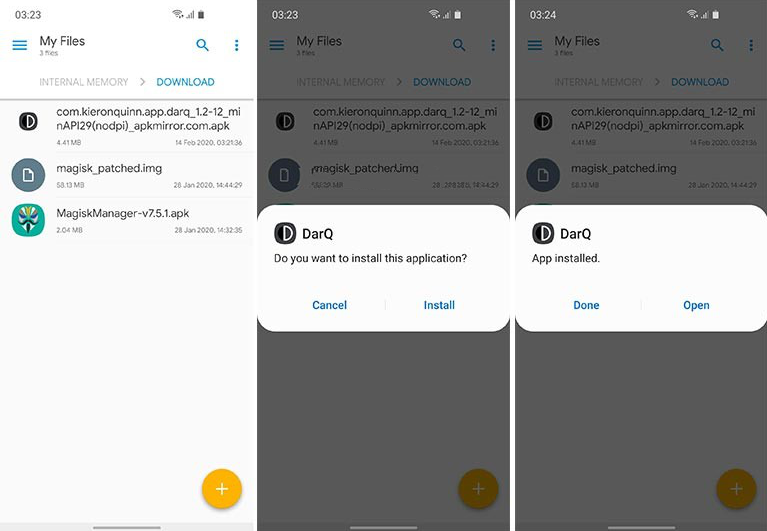
- Tap on the APK file and press the ‘Install’ button to put in the DarQ app on your Android 10 device.
- After installation, go to the app drawer and launch it.
- You’ll be prompted to grant it accessibility permissions.
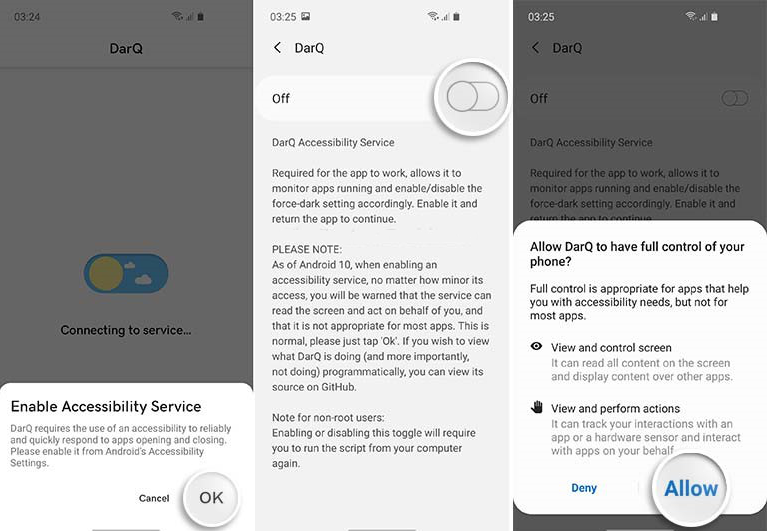
- Simply tap on “Ok” when prompted to activate the toggle for DarQ Accessibility Service.
- Now, download the DarQ ADB Script zip file on the PC.
- Extract the downloaded file to an appropriate location on the PC.

- Enable USB Debugging and connect your Android 10 device to the PC using the USB cable.
- If you’re using Windows PC, simply double-click on the “rundarq-windows.bat” file.
- If you’re using macOS/Linux, launch the Terminal and enter the subsequent command:
- The script will automatically run the background service required by DarQ.

- Once done, return to the DarQ app on your device and it should be operational
- the primary step is to form sure that you simply have turned on the system-wide Dark Mode on your device. If you continue to haven’t, then just activate the ‘Enable Dark Theme’ toggle in DarQ.
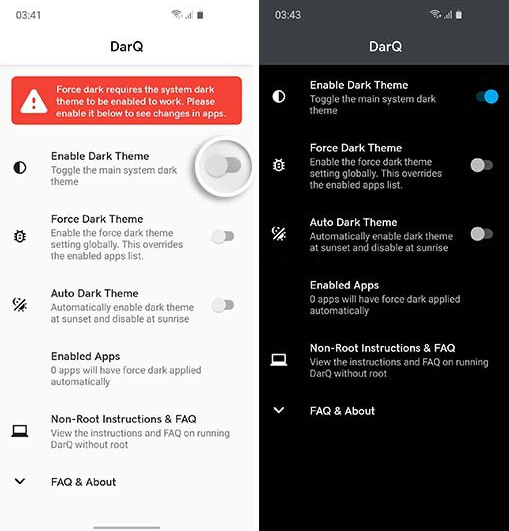
- Now, to enable per-app Dark Mode on your Android 10 device, attend the ‘Enabled App’ section of the app.
- Finally, just select the apps that you would like to enable the dark theme.
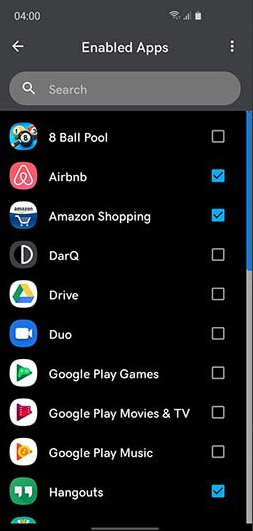
That’s it! Your selected apps should now have a forced dark theme, even if it doesn’t support it yet. Below are screenshots for a couple of apps that don’t support a dark theme yet and enabled via DarQ.
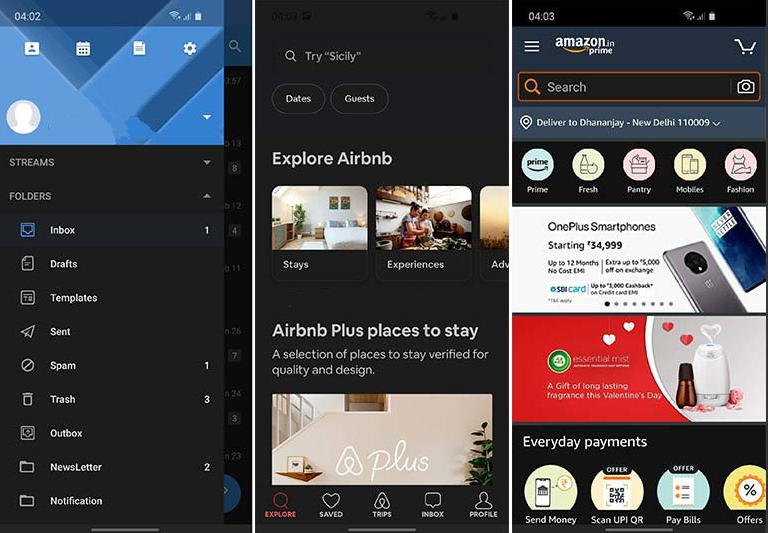
Note: You do not need to keep your device connected to the PC for DarQ to run, but only until you reboot the device. So, to use DarQ on unrooted devices, you’ll get to run it whenever your reboot/restart your phone.






